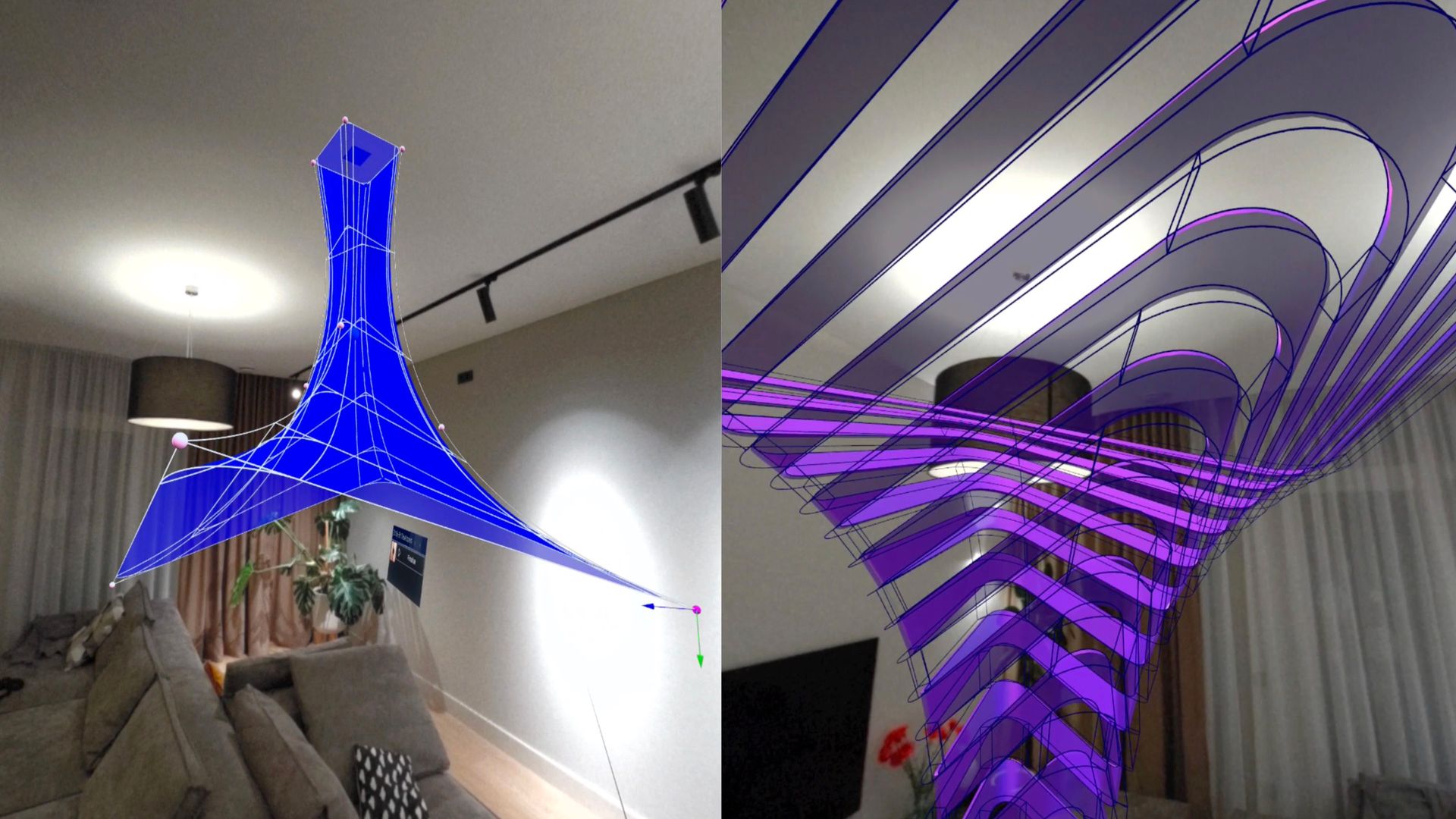Our latest experiment demonstrates that it is possible to use our CAD algorithms in a mixed reality environment.
Feb 17, 2023
by Matas Ubarevicius
We have created a small application that utilizes Meta Quest Pro to display and interact with parametric 3D models in a mixed reality environment. The 3D models are generated using a combination of open-source and proprietary CAD algorithms, and we have also developed a custom WebXR interaction layer for our internal use in the application. This allows users to manipulate the 3D models in real-time using a range of intuitive and user-friendly tools, enhancing the immersive and interactive experience of using CAD in the metaverse.

User interacting with the parametric 3D model in mixed reality.
Mixed reality is an exciting new frontier for computer-aided design applications, and we are thrilled to share our latest parametric experiment with you. With the help of Meta Quest Pro and WebXR we have created an experimental CAD application that allows users to build designs directly in their surroundings.
We have developed several user interaction concepts to make the experience feel as natural as possible, and while there is still room for improvement, we believe this demo effectively showcases the potential of our platform.
Our approach to CAD modelling uses a constraint-driven system, with pre-programmed control nodes that can only be moved in specific directions. This lightweight "sketch" design provides a solid foundation for creating the final shape of the design. Once the nodes are in place and the design is fully adapted to our needs, we simply click a button in the floating panel to compute the final result, which can be inspected on-the-go.
In Depth Experience Video
To showcase our application's capabilities, we have produced a video that depicts a user interacting with a parametric 3D model in a mixed reality environment. The video can also be found on our YouTube channel. Hit subscribe if you enjoy it.
Further in this blog post we will discuss our view on the future of CAD industry within the metaverse and our goals to provide a lot of new applications that could be tuned for specific use cases.
Exploring the Role of CAD in the Metaverse
The metaverse, a concept popularized in Neal Stephenson's 1992 novel Snow Crash, refers to a virtual world where people can interact with each other and with digital objects in a seamless and immersive way. In recent years, the discourse around the metaverse has largely centered around two main use cases: gaming and social networking. However, there has been relatively little discussion about the potential role of computer-aided design (CAD) in the metaverse. In this blog post, we will explore some possible reasons why this is the case and offer our take on it.
One possible reason for the lack of attention given to CAD in the metaverse is that the technology for creating immersive and interactive virtual worlds is still relatively new and rapidly evolving. Companies such as Roblox, Epic Games, and Facebook (now Meta) are investing billions of dollars in developing the infrastructure and tools necessary to create metaverse environments that can support large numbers of concurrent users and allow them to interact with each other in real-time. These companies have primarily focused on gaming and social networking because these use cases have proven to be the most popular and profitable in the early days of the metaverse. However, as the technology matures and more use cases emerge, it can be that CAD will become a more prominent part of the metaverse.
Another possible reason why CAD has not been a major focus of the metaverse is that the software and hardware required to create and interact with 3D models in real-time are still relatively expensive and could not fit the size of the regular headset. Additionally, many CAD software companies have been slow to embrace the metaverse, perhaps because they see it as a potential threat to their existing business models or other reasons. As the metaverse continues to evolve and mature, it is possible that software companies will begin to see the CAD metaverse as an opportunity to expand their user base and increase their revenues.
Bridging the Gap: Our Approach to CAD on the Metaverse
One potential solution to the lack of CAD adoption in the metaverse is the creation of simplified design applications that can run in the metaverse environments. By leveraging our CAD algorithms, we plan to develop a variety of these applications to help address the issues that have limited the adoption of CAD in the metaverse.
Our plan is to create easy to use apps that are more accessible and affordable than traditional CAD software, making it easier for a wider range of people to create and manipulate 3D models in real-time. By offering these applications through app stores, we will be able to provide a more immersive and interactive experience, unlocking the potential of CAD in the metaverse for a wider range of use cases beyond just architecture and engineering.
We hope that this will help to bridge the gap between traditional CAD workflows and the more intuitive and interactive workflows required in the metaverse. With a range of user-friendly tools for creating and manipulating 3D models in real-time, our applications will help to unlock the full potential of CAD in the metaverse and pave the way for new and innovative use cases and applications.
In conclusion, we believe that the development of parametric and model oriented CAD applications has the potential to overcome the barriers that have limited the adoption of CAD in the metaverse. By leveraging our expertise, we will develop these applications to help unlock the full potential of CAD in the metaverse and pave the way for a wider range of use cases and applications.
